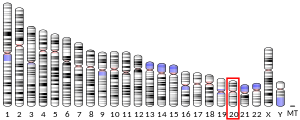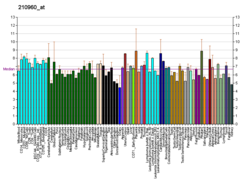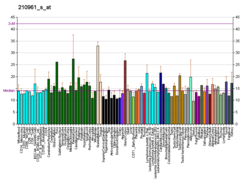Alpha-1D adrenergic receptor
Appearance
(Redirected from Alpha-1D adrenoceptor)
The alpha-1D adrenergic receptor (α1D adrenoreceptor), also known as ADRA1D, is an alpha-1 adrenergic receptor, and also denotes the human gene encoding it.[5]
Receptor
[edit]There are 3 alpha-1 adrenergic receptor subtypes: alpha-1A, -1B and -1D, all of which signal through the Gq/11 family of G-proteins and different subtypes show different patterns of activation. They activate mitogenic responses and regulate growth and proliferation of many cells.
Gene
[edit]This gene encodes alpha-1D-adrenergic receptor. Similar to alpha-1B-adrenergic receptor gene, this gene comprises 2 exons and a single intron that interrupts the coding region.[5]
Ligands
[edit]Many α1 receptor ligands are non-selective for receptor subtypes.
- Antagonists
- A-315456[6]
- BMY 7378 (also α2C antagonist)[7]
- Domesticine[8]
- Cyclazosin (slight α1C selectivity)[9]
- Tamsulosin (roughly equal affinity for α1A)[9]
See also
[edit]References
[edit]- ^ a b c GRCh38: Ensembl release 89: ENSG00000171873 – Ensembl, May 2017
- ^ a b c GRCm38: Ensembl release 89: ENSMUSG00000027335 – Ensembl, May 2017
- ^ "Human PubMed Reference:". National Center for Biotechnology Information, U.S. National Library of Medicine.
- ^ "Mouse PubMed Reference:". National Center for Biotechnology Information, U.S. National Library of Medicine.
- ^ a b "Entrez Gene: ADRA1D adrenergic, alpha-1D-, receptor".
- ^ Buckner SA, Milicic I, Daza A, Lynch JJ, Kolasa T, Nakane M, et al. (December 2001). "A-315456: a selective alpha(1D)-adrenoceptor antagonist with minimal dopamine D(2) and 5-HT(1A) receptor affinity". European Journal of Pharmacology. 433 (1): 123–127. doi:10.1016/s0014-2999(01)01519-9. PMID 11755142.
- ^ Cleary L, Murad K, Bexis S, Docherty JR (October 2005). "The alpha (1D)-adrenoceptor antagonist BMY 7378 is also an alpha (2C)-adrenoceptor antagonist". Autonomic & Autacoid Pharmacology. 25 (4): 135–141. doi:10.1111/j.1474-8673.2005.00342.x. PMID 16176444.
- ^ Indra B, Matsunaga K, Hoshino O, Suzuki M, Ogasawara H, Muramatsu I, et al. (June 2002). "(+/-)-Domesticine, a novel and selective alpha1D-adrenoceptor antagonist in animal tissues and human alpha 1-adrenoceptors". European Journal of Pharmacology. 445 (1–2): 21–29. doi:10.1016/s0014-2999(02)01601-1. PMID 12065190.
- ^ a b Proudman RG, Pupo AS, Baker JG (August 2020). "The affinity and selectivity of α-adrenoceptor antagonists, antidepressants, and antipsychotics for the human α1A, α1B, and α1D-adrenoceptors". Pharmacology Research & Perspectives. 8 (4): e00602. doi:10.1002/prp2.602. PMC 7327383. PMID 32608144.
Further reading
[edit]- Schwinn DA, Lomasney JW (December 1992). "Pharmacologic characterization of cloned alpha 1-adrenoceptor subtypes: selective antagonists suggest the existence of a fourth subtype". European Journal of Pharmacology. 227 (4): 433–436. doi:10.1016/0922-4106(92)90162-O. PMID 1359975.
- Bruno JF, Whittaker J, Song JF, Berelowitz M (September 1991). "Molecular cloning and sequencing of a cDNA encoding a human alpha 1A adrenergic receptor". Biochemical and Biophysical Research Communications. 179 (3): 1485–1490. doi:10.1016/0006-291X(91)91740-4. PMID 1656955.
- Esbenshade TA, Hirasawa A, Tsujimoto G, Tanaka T, Yano J, Minneman KP, et al. (May 1995). "Cloning of the human alpha 1d-adrenergic receptor and inducible expression of three human subtypes in SK-N-MC cells". Molecular Pharmacology. 47 (5): 977–985. PMID 7746284.
- Schwinn DA, Johnston GI, Page SO, Mosley MJ, Wilson KH, Worman NP, et al. (January 1995). "Cloning and pharmacological characterization of human alpha-1 adrenergic receptors: sequence corrections and direct comparison with other species homologues". The Journal of Pharmacology and Experimental Therapeutics. 272 (1): 134–142. PMID 7815325.
- Weinberg DH, Trivedi P, Tan CP, Mitra S, Perkins-Barrow A, Borkowski D, et al. (June 1994). "Cloning, expression and characterization of human alpha adrenergic receptors alpha 1a, alpha 1b and alpha 1c". Biochemical and Biophysical Research Communications. 201 (3): 1296–1304. doi:10.1006/bbrc.1994.1845. PMID 8024574.
- Loftus SK, Shiang R, Warrington JA, Bengtsson U, McPherson JD, Wasmuth JJ (1994). "Genes encoding adrenergic receptors are not clustered on the long arm of human chromosome 5". Cytogenetics and Cell Genetics. 67 (2): 69–74. doi:10.1159/000133802. PMID 8039425.
- Yang-Feng TL, Han H, Lomasney JW, Caron MG (1994). "Localization of the cDNA for an alpha 1-adrenergic receptor subtype (ADRA1D) to chromosome band 20p13". Cytogenetics and Cell Genetics. 66 (3): 170–171. doi:10.1159/000133693. PMID 8125015.
- Forray C, Bard JA, Wetzel JM, Chiu G, Shapiro E, Tang R, et al. (April 1994). "The alpha 1-adrenergic receptor that mediates smooth muscle contraction in human prostate has the pharmacological properties of the cloned human alpha 1c subtype". Molecular Pharmacology. 45 (4): 703–708. PMID 8183249.
- Minneman KP, Lee D, Zhong H, Berts A, Abbott KL, Murphy TJ (June 2000). "Transcriptional responses to growth factor and G protein-coupled receptors in PC12 cells: comparison of alpha(1)-adrenergic receptor subtypes". Journal of Neurochemistry. 74 (6): 2392–2400. doi:10.1046/j.1471-4159.2000.0742392.x. PMID 10820200. S2CID 16002509.
- Keffel S, Alexandrov A, Goepel M, Michel MC (June 2000). "alpha(1)-adrenoceptor subtypes differentially couple to growth promotion and inhibition in Chinese hamster ovary cells". Biochemical and Biophysical Research Communications. 272 (3): 906–911. doi:10.1006/bbrc.2000.2850. PMID 10860850.
- Kyprianou N, Benning CM (August 2000). "Suppression of human prostate cancer cell growth by alpha1-adrenoceptor antagonists doxazosin and terazosin via induction of apoptosis". Cancer Research. 60 (16): 4550–4555. PMID 10969806.
- Shibata K, Katsuma S, Koshimizu T, Shinoura H, Hirasawa A, Tanoue A, et al. (January 2003). "alpha 1-Adrenergic receptor subtypes differentially control the cell cycle of transfected CHO cells through a cAMP-dependent mechanism involving p27Kip1". The Journal of Biological Chemistry. 278 (1): 672–678. doi:10.1074/jbc.M201375200. PMID 12409310.
- Pupo AS, Minneman KP (2004). "Specific interactions between gC1qR and alpha1-adrenoceptor subtypes". Journal of Receptor and Signal Transduction Research. 23 (2–3): 185–195. doi:10.1081/RRS-120025200. PMID 14626446. S2CID 29600903.
- Hague C, Uberti MA, Chen Z, Hall RA, Minneman KP (April 2004). "Cell surface expression of alpha1D-adrenergic receptors is controlled by heterodimerization with alpha1B-adrenergic receptors". The Journal of Biological Chemistry. 279 (15): 15541–15549. doi:10.1074/jbc.M314014200. PMID 14736874.
- Gonzalez-Cabrera PJ, Shi T, Yun J, McCune DF, Rorabaugh BR, Perez DM (November 2004). "Differential regulation of the cell cycle by alpha1-adrenergic receptor subtypes". Endocrinology. 145 (11): 5157–5167. doi:10.1210/en.2004-0728. PMID 15297446.
- Zhang T, Xu Q, Chen FR, Han QD, Zhang YY (November 2004). "Yeast two-hybrid screening for proteins that interact with alpha1-adrenergic receptors". Acta Pharmacologica Sinica. 25 (11): 1471–1478. PMID 15525470.
- Sigala S, Dellabella M, Milanese G, Fornari S, Faccoli S, Palazzolo F, et al. (2005). "Evidence for the presence of alpha1 adrenoceptor subtypes in the human ureter". Neurourology and Urodynamics. 24 (2): 142–148. doi:10.1002/nau.20097. PMID 15690361. S2CID 23187341.
- Chen Z, Hague C, Hall RA, Minneman KP (May 2006). "Syntrophins regulate alpha1D-adrenergic receptors through a PDZ domain-mediated interaction". The Journal of Biological Chemistry. 281 (18): 12414–12420. doi:10.1074/jbc.M508651200. PMID 16533813.
- Michelotti GA, Brinkley DM, Morris DP, Smith MP, Louie RJ, Schwinn DA (July 2007). "Epigenetic regulation of human alpha1d-adrenergic receptor gene expression: a role for DNA methylation in Sp1-dependent regulation". FASEB Journal. 21 (9): 1979–1993. doi:10.1096/fj.06-7118com. PMC 2279228. PMID 17384146.
External links
[edit]- Human ADRA1A genome location and ADRA1A gene details page in the UCSC Genome Browser.
- Human ADRA1D genome location and ADRA1D gene details page in the UCSC Genome Browser.






